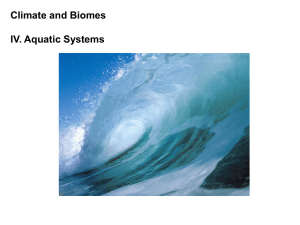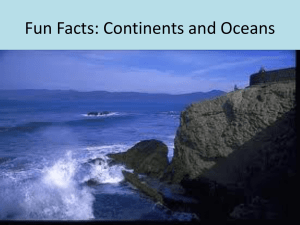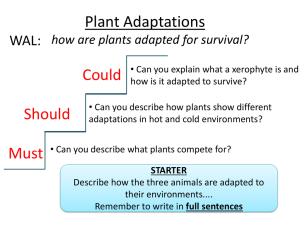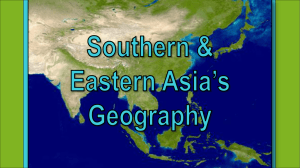Habitats 2 Lecture Slides ZLY 101
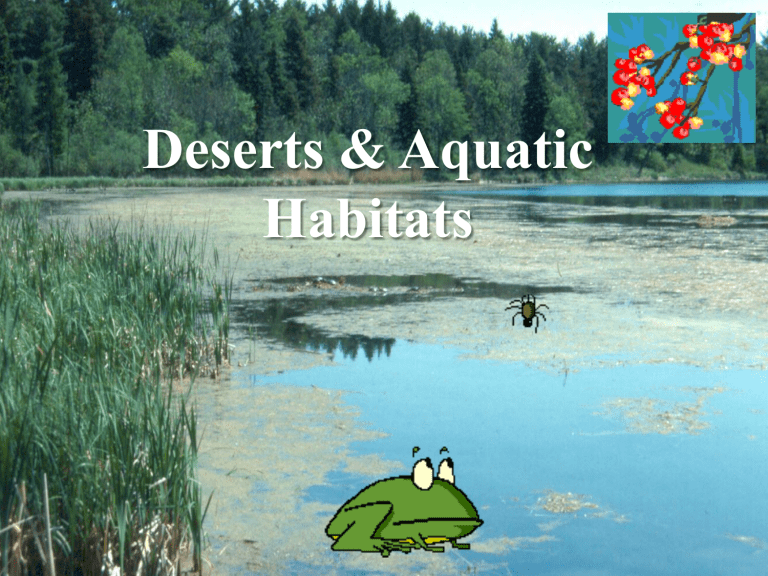
Deserts & Aquatic
Habitats
Desert
•
Deserts are arid regions where rainfall is low (less than 25 cm [10 inches] a year), and water evaporation is high.
•
The North American desert is of two parts, the hot deserts of the southwest (Mohave, Sonoran, and
Chihuahuan) and the cool, high desert in the rain shadow of the High Sierras and the Cascade mountains.
Animals that live in the desert:
Desert
•
Desert plants, such as thorny shrubs and cacti, have reduced foliage, drought-resistant seeds, and other adaptations for conserving water.
•
Many large desert animals have developed remarkable anatomical and physiological adaptations for keeping cool and conserving water.
•
Most smaller animals avoid the most severe conditions by living in burrows or developing nocturnal habits.
•
Mammals include mule deer, peccary, cottontail, jackrabbit, kangaroo rat, and ground squirrel.
•
Typical birds are roadrunner, cactus wren, turkey vulture, and burrowing owl. Reptiles are numerous, and a few species of toads are common.
•
Arthropods include a great variety of insects and arachnids.
Desert Fauna Adaptive Features
•
Lack of water creates a survival problem, fauna are more susceptible to extremes of temperature than are plants.
•
Animals receive heat directly by radiation from the sun, and indirectly, by conduction from the substrate
(rocks and soil) and convection from the air.
•
Biological processes function within narrow temperature ranges,
•
For four or five months of the year, the daily temperatures in the desert may actually exceed this range, called the range of thermoneutrality .
•
Combined with the scarcity of life-sustaining water, survival for desert animals can become extremely tenuous.
Desert Fauna Adaptive Features
Avoiding Heat
•
Behavioral techniques for avoiding excess heat are numerous among desert animals.
•
Certain species of birds, Phainopepla breed during the relatively cool spring, then leave the desert for cooler areas at higher elevations or along the Pacific coast.
•
The Costa's Hummingbird, begins breeding in late winter, then leaves in late spring when temperatures become extreme.
•
Many birds are active primarily at dawn and within a few hours of sunset, retiring to a cool, shady spot for the remainder of the day.
Desert Fauna Adaptive Features
Avoiding Heat
• Many animals (especially mammals and reptiles) are
crepuscular (active only at dusk and again at dawn) e.g.
rattlesnakes and Gila Monsters.
• Many animals are completely nocturnal, restricting all their activities to the cooler temperatures of the night e.g.
Bats, many snakes, most rodents and some larger mammals.
• Some smaller desert animals burrow below the surface of the soil or sand to escape the high temperatures at the desert surface. These include many mammals, reptiles, insects and all the desert amphibians. Rodents may plug the entrances to their burrows to keep out hot, desiccating air.
Desert Fauna Adaptive
Features
Avoiding Heat
•
Many animals (mammals and reptiles) are crepuscular
(active only at dusk and again at dawn) e.g. rattlesnakes and Gila Monsters.
•
Many animals are completely nocturnal e.g. Bats, many snakes, most rodents and some larger mammals.
•
Some animals burrow below the surface of the soil or sand e.g.
mammals, reptiles, insects and desert amphibians.
•
Rodents may plug the entrances to their burrows to keep out hot, desiccating air.
Desert Fauna Adaptive
Features
Water Storage
•
Water can be stored by animals in fatty deposits in their tails and other tissues (e.g., in the gila monster’s tail).
•
Minimize loss of water out of the skin (cutaneous loss), from urine and feces (excretory loss), and from "breathing"
(respiratory loss) through various means.
•
Tolerate Hyperthermia
Some plants and animals can survive body temperatures that would be dangerous to humans (e.g. antelope squirrel tolerates body temperatures over 104 0 F).
Desert Fauna Adaptive
Features
•
New World vultures, (turkey & black vultures), are dark in color and thus absorb considerable heat in the desert.
•
They excrete urine on their legs, cooling them by evaporation, and circulate the cooled blood back through the body.
•
This behavior, called urohydrosis , is shared with their relatives the storks, successful birds of the
African deserts.
•
Vultures and storks may escape the hot midday temperatures of the desert by soaring effortlessly, high on thermals of cooler air.
Desert Fauna Adaptive
Features
•
Reptiles and birds excrete metabolic wastes in the form of uric acid, an insoluble white compound, wasting very little water in the process.
•
Mammals, however, excrete urea, a soluble compound that accounts for considerable water loss.
Most mammals, therefore, need access to a good supply of fresh water, at least every few days, if not daily.
•
Some insects tap plant fluids such as nectar or sap from stems, while others extract water from the plant parts they eat, such as leaves and fruit.
Desert Fauna Adaptive
Features
•
Jackrabbits have large ears that are supplied with a large number of blood vessels from which excess heat can be easily lost.
•
Light colors are better absorbers of heat than dark colors. Most desert animals are pale in color.
Aquatic Habitats
•
Aquatic habitats may be either freshwater like lakes, ponds, rivers, spring or saline (salt water) like oceans.
•
A wide variety of organisms lives in these habitats.
•
Sudden change in water temperature is not observed because water absorbs and loses heat gradually.
•
Over 99.9% of the surface water is available as freshwater for various human needs.
•
Aquatic habitat offers a variety of physicochemical factors, which includes light penetration (transparency), availability of oxygen, resistance to motion (viscosity), pressure fluctuations, nutrients, etc.
Aquatic Habitats
Inland Waters
•
Only 2.5% is fresh water, it is contained in polar ice caps, or stored underground in aquifers and soil moisture, leaving only 0.01% of the world’s inland waters available as habitat for aquatic life.
•
A quarter of the world’s vertebrates and nearly half of its fishes live in these fragile “islands” of water.
•
Inland waters are divided broadly in to two:-
–
Running-water, or lotic (L. lotus, action of washing) habitats,
– standing-water, or lentic (L. lentus, slow) habitats.
Aquatic Habitats
Lotic habitats
They follow a gradient from mountain brooks to streams and rivers.
Brooks and streams with high-velocity water flow are high in dissolved oxygen because of their turbulence.
Energy input is chiefly in the form of organic detritus washed from adjacent terrestrial areas.
More slowly moving rivers have less dissolved oxygen and more floating algae and plants.
Their Fauna is tolerant of lower O
2 concentration.
Aquatic Habitats
Lentic habitats
Such as ponds and lakes, tend to have still lower concentrations of oxygen, particularly in the deeper areas.
Animals living on the bottom or on submerged vegetation (benthos) include snails and mussels, crustaceans, and a wide variety of insects.
Many swimming forms, called nekton, are found in lakes and larger ponds.
Depending on the nutrients available, a large contingent of small floating or weakly swimming plants and animals (plankton) may occur.
Aquatic Habitats
Ponds and lakes have short lifespans - a few hundred to many thousands of years depending on size and rate of sedimentation, they and undergo great physical change as they age.
Many freshwater habitats have been severely damaged by human pollution such as dumping of toxic industrial wastes and enormous quantities of sewage.
The inflow of large amounts of nitrates and phosphates has lead to the lakes been fertilized leading to huge blooms of algae that die and sink to the bottom to decompose and rob the lake of oxygen.
Aquatic Habitats
Oceans
Oceans are by far the largest portion of the earth’s biosphere.
They cover 71% of the earth’s surface to an average depth of 3.75 km, with their greatest depths reaching to more than 11.5 km below sea level.
The marine world is relatively uniform as compared with land, and in many respects it is less demanding on life forms.
However, the evident monotony of the ocean’s surface belies the variety of life below.
Aquatic Habitats
Oceans are the cradle of life, and this is reflected by the variety of organisms living there.
More than 200,000 species of unicellular forms, plants, and animals inhabit oceans.
About 98%, live on the seabed (benthic); only 2% live freely in the open ocean (pelagic).
Of the benthic forms, most fauna occur in the intertidal zone or shallow depths of the oceans.
Less than 1% live in the deep ocean below 2000 m.
Aquatic Habitats
The most productive areas are concentrated along continental margins and a few areas where the waters are enriched by organic nutrients and debris lifted by upwelling currents into the sunlit, or photic, zone, where photosynthetic activity occurs.
With certain notable exceptions, all life below the photic zone must be supported by the light “rain” of organic particles from above.
Aquatic Habitats
Life in the ocean is divided into regions, or provinces, each with its own distinctive life forms:-
1. The littoral, or intertidal zone: Where sea and land meet.
This is paradoxically both the harshest and the richest of all marine environments.
The animals living there, are subjected to pounding, surf, sun, wind, rain, extreme temperature fluctuations, erosion and sedimentation.
A great diversity of available habitats and the bounteous supply of nutrients has made animals such as barnacles, snails, chitons, limpets, mussels, sea urchins, sea stars, and many others flourish there.
Aquatic Habitats
2. The sublittoral, or subtidal zone, which is always submerged.
It also supports a rich variety of animal life, as well as forests of brown algae.
Major Marine Zones
Distribution of Fauna based on Different Ocean
Zones
Distribution of Fauna based on Different Ocean
Zones
Aquatic Habitats
E stuary
•
This is a semi enclosed transition zone where fresh water flows into the sea.
•
Despite unstable salinity caused by the variable entry of freshwater, the estuary is a nutrient-rich habitat that supports a diverse fauna.
•
The neritic (shallow) water zone surrounds the continents and extends to the edge of the continental shelf
(approximately to a depth of 200m).
•
The neritic zone is more productive than the open ocean because it benefits from nutrients delivered by rivers and by upwelling at the edge of the shelf.
•
Algal growth is prolific, which in turn supports a diverse animal life, including most of the world’s fisheries.
Aquatic Habitats
•
Areas of upwelling, although small and restricted to a few regions, are vital sources of nutrient renewal for the surface photic zone.
•
Some of the world’s most productive fisheries are/or were centered on upwelling regions.
•
The vast open ocean (p elagic) realm comprising 90% of the total oceanic area.
•
The pelagic realm is relatively impoverished biologically because, as organisms die, they sink out of the photic zone, carrying nutrients into the bathypelagic zone where they are immobilized.
Aquatic Habitats
•
Below the surface, or epipelagic, layers of the pelagic realm are the great ocean depths, characterized by enormous pressure, perpetual darkness, and a constant temperature near 0° C.
•
There are several distinct habitats in the ocean depths, the mesopelagic is the “twilight zone.”
Aquatic Habitats
•
Possession of special structures like floats, air cavities, air sacs which help them to float in water at the desired depth.
•
For movement, animals have special appendages, for example, fishes have streamlined body and fins.
•
Animals develop special coverings like shells, cuticle, waxy coating, scales, etc. which prevent rotting and decay.
•
Animals have the ability to feed in water.
•
For respiration and exchange of gases animals have developed special structures such as gills in fishes.
Adaptations to Aquatic
Habitats
•
Some things to look for in aquatic animal adaptations are:
•
Flotation - to aid flotation some organisms are able to accumulate gasses around their body or have a bladder they fill or empty to allow movement up and down the water column body shape –
• some animals are aqua dynamic (slender in shape) to aid swimming,
• some are shaped like other objects such as leaves to provide disguise or camouflage, others have very slender bodies to aid in burying in the mud and detritus
Adaptations to Aquatic
Habitats
• respiration - the method of acquiring oxygen can be quite specific such as gills, simple diffusion or atmospheric oxygen.
•
The shape and location of the breathing apparatus can also be a specific adaptation such as breather tubes, fins as gills and hairs acting as additional surface area to absorb oxygen from the water or to trap atmospheric oxygen and allow diving.
Adaptations to Aquatic
Habitats
• locomotion - aquatic invertebrates may have quite specific adaptations such as flattened legs for paddles, additional hairs to increase the paddle affect of legs, one set larger than the others, expulsion of water as additional propulsion, fins in a fan shape to open and close for greater or less surface area or wings to allow them to move from one water body to the next.
• skeleton - whilst most will have an exoskeleton it will vary to perform different functions, segmentation to allow movement, tube shaped for breathing or a hard shell for defence.
Adaptations to Aquatic
Habitats
Water Boatman (Agraptocorixia eurynome)
• have an extended pair of legs for swimming
• hairy bodies to trap a bubble of air for diving
• wings to leave the water body
• mouth parts for biting into hard skeletons and sucking out the contents of the organism
• compound eyes for greater all round vision
Backswimmer (Anisops inconstans)
• similar to water boatman except for a much more slender body and longer extended legs to aid in locomotion
• swims on its back with a bubble of air for respiration
Adaptations to Aquatic
Habitats
Dragonfly Nymph (Odonata, Anisoptera - Orethetrum
caledonicum)
• has an extendable lower jaw to grasp its prey
• strong legs for grasping reeds and assisting in swimming
• internal anal gills that double as a form of locomotion
• when required as water is expelled
• compound eyes for better field of view
• colouration to disguise themselves amongst the detritus and algae
Adaptations to Aquatic
Habitats
• Damselfly Nymph (Odonata, Zygoptera -)
• is similar to the dragonfly except its anal gills are external and used as swim fins for locomotion
• it can also cling to reeds in flowing water and use the water motion over its gills to aid respiration
• Pond Snail (Isidorella haiinesii, Physastra gibbosa)
• has a very hard outer shell it can retract into for defence
• extendable eye sockets for pripheral vision
• a rasping tongue to remove algae from surfaces
• colouration and shape to camouflage as a rock and secretion of mucus to aid in attaching to a surface and sliding over it
Adaptations to Aquatic
Habitats
Pond Skater (Hemiptera)
• has long hairy legs to assist in water tension and fast movement on the surface of water
• compound eyes for increased vision
• surface breather so it is very tolerant of water conditions
• requires some cover to protect against wind
• found in slow moving or still water
•
Mosquito Fish (Gambusia affinis)
• a streamlined minnow shaped small fish with a voracious appetite is an introduced species very aquadynamic
Adaptations to Aquatic
Habitats
Freshwater Shrimp (Parayta australensis)
• has a segmented exoskeleton that allows it a wide range of movement as well as protection
• tail fans out for locomotion
• mouth parts are extended into a comb shape and fine hairs on this aid in sweeping algae and detritus into the mouth
• long feelers aid in detection of food and surfaces in dark areas
• eyes are on stalks to increase peripheral vision
Adaptations to Aquatic
• Water Spider (Pisauridae)
Habitats
• has very hairy legs and body to assist in surface tension and to hold a bubble of air if submerged it builds a web near the water amongst the reeds capturing emerging aquatic insects and terrestrial ones
• It will also submerge to seek out prey
Caddisfly Larvae (Trichoptera)
• uses modified mouth parts to scrape a thin film of algae from the surface of stones and plants
• has additional pro-legs to attach to the case it lives in
• can manufacture case by gluing together small sticks with a sticky secretion
Adaptations to Aquatic
Habitats
Tadpole (Limnodynastes peronii)
• has a flattened tail for swimming
• teeth adapted to scraping off algae and chewing on other soft bodied organisms
• gills for efficient respiration
• haemoglobin for efficiency in extracting oxygen
• are fast growers to survive ephemeral water bodies


